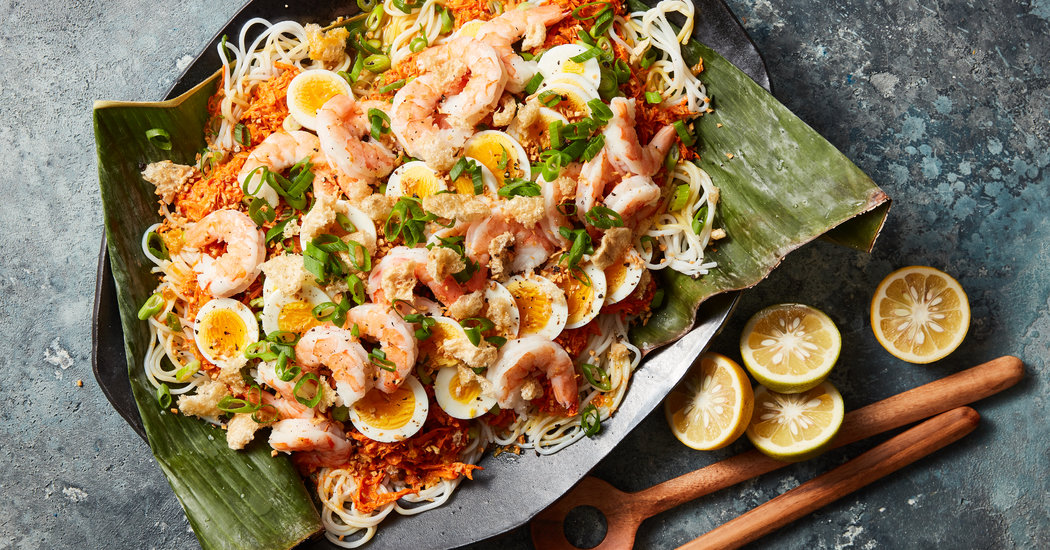Traditional dishes often symbolize better luck for the future — and they promise a satisfying meal here and now.
If Jan. 1 didn’t feel like quite the annual reset you were hoping for, you can celebrate now by cooking for the Lunar New Year, which falls on the day of the first full moon after the winter solstice. For this Year of the Tiger, that’s Feb. 1, and the inaugural feast commences the night before. In China and other Asian countries that recognize the holiday, such as Singapore, Vietnam and South Korea, the festivities can last for two weeks, and the foods often symbolize promises for a better year ahead. But the immediate reward is something delicious to eat, whether you’re preparing a feast or just one dish.
1. Peking Duck With Honey and Five-Spice Glaze
A highlight of restaurant banquets, this dish can be made at home, too, especially with streamlined techniques from Kay Chun. It keeps with the tradition of serving whole poultry to signal abundance. But it also tastes more special than chicken and feels like a celebration in both the cooking process and in serving.
Long noodles symbolize long life, and there are endless variations for the holiday dish beyond classic Cantonese longevity noodles. This Singaporean version, topped with egg ribbons and crisp shallots, comes from Sharon Wee, the author of “Growing Up in a Nonya Kitchen.” She suggests topping it with spicy sambal belacan, a hot sauce made savory with shrimp paste.
Recipe: Nonya Hokkien Stir-Fried Noodles
3. Thit Heo Kho Trung (Pork and Eggs in Caramel Sauce)
For Tết, the Vietnamese Lunar New Year, the cookbook author Andrea Nguyen often makes this classic holiday dish. The rich combination of pork and eggs gets its savory flavor from fish sauce and a little sweetness from coconut water and caramel, which also brings a welcome bitter edge. Ms. Nguyen serves the dish over steamed rice and with pickled bean sprout salad to offer a refreshing contrast.
Recipe: Thit Heo Kho Trung (Pork and Eggs in Caramel Sauce)
4. Tang Yuan
The sticky texture and round shape of these Chinese New Year dessert dumplings symbolize family unity, and therefore promise togetherness for the year ahead. With the tender chew of a marshmallow and a nougat-like sesame filling, these rounds are served in a sweet ginger soup. They’re easy to form and freeze well, so you can prepare a big batch at once and eat them throughout the holiday season.
Recipe: Tang Yuan
5. Mandu
The Korean New Year, Seollal, is commemorated with tteok mandu guk, a steaming soup filled with sticky rice cakes, which one is supposed to eat so they can see their next birthday. Mandu, dumplings, aren’t necessary, but they taste delicious in the broth, especially when made from scratch using this recipe from Julya Shin and Steve Joo.
Recipe: Mandu
6. Pancit Palabok (Rice Noodles With Chicken Ragout and Shrimp)
In the Philippines, noodles for longevity take on many forms, and this dish is among the richest. Finely shredded chicken simmers into a fragrant sauce to thicken it, and plump shrimp top the noodles, along with boiled eggs and crunchy chicharron, in this recipe from the chef Angela Dimayuga.
Recipe: Pancit Palabok (Rice Noodles With Chicken Ragout and Shrimp)
7. Steamed Whole Fish With Ginger and Sesame
The Chinese word for fish sounds like the word for plentiful surplus, so a whole steamed one symbolizes good fortune for the year ahead. You can prepare an elaborate version or this simpler one from David Tanis.
Crackly candied nuts and seeds are set out and shared throughout the Lunar New Year season. They’re easy to buy online or in Asian markets, but they’re arguably even easier to make at home following this candy recipe from Andrea Nguyen.


























